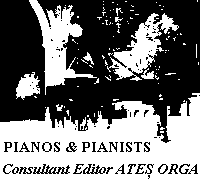|
 |
JAN LADISLAV DUSSEK : 1
Bohemian Romantic
(1760-1812)
|
'... the most honest, politest and most excellent man among
all composers ...'
- Haydn, 1792
Apprenticeship
Enlightenist and Revolutionary, Jan Ladislav Dussek (more properly Vaclav
Jan Dusik) was one of the most celebrated composers and pianists of his
age, a quintessential Classico-Romantic who travelled the civilised stage
of Europe at its time, arguably, of greatest modern historical moment. Born
in Bohemia, his early years were spent in the Netherlands and Germany (where
he met, and may have taken lessons from, Bach's second eldest son, Carl
Philip Emannuel); in St Petersburg (where, in 1783, he became implicated
in a plot against Catherine II); and in Berlin (where, in 1784, he formally
presented himself as a pianist).
Goes to London
1786 witnessed his first appearance in Paris: here he attracted the notice
of Marie Antoinette, becoming one of her favourite musicians. He didn't
stay long. Sensing revolution and the demise of his old world, he looked
to England, making his way across the Channel in the late spring of 1789.
In London, following a debut at one of Salomon's subscription concerts (Hanover
Square Rooms, June 1st 1789), he befriended Clementi and Haydn; encouraged
John Broadwood to expand the compass of the piano to six octaves (playing
such an instrument in 1794); married a singer and harpist (the daughter
of an Italian singing-master); gave lessons (publishing a volume of Instructions
on the Art of Playing the Piano-Forte or Harpsichord in 1796); and,
together with his father-in-law, Domenico, founded a music business - Corri
& Dussek Comp, Purveyor of Music 'to their Majesties, their Royal Highnesses
the Prince of Wales and the Duchess of York', with premises eventually at
67/68 Dean Street, Soho. In late 1799 this speculation collapsed. Facing
bankruptcy and the debtor's jail, he headed back for Europe, his flight
kept secret. Behind, he left a partner in prison and a wife and infant daughter
he was not to see again.
'The ideal for every artistic performance'
The final chapter of his life was one of triumph occluded by tragedy.
Noteworthy were concerts in Hamburg (where he made the acquaintance of Spohr,
Steibelt and Nancy Storace - Mozart's original Susanna); and his starry
return to Prague in 1802 - remembered over forty years later by Tomasek
in his Autobiography:
| 'There was ... something magical about the way in which Dussek with all
his charming grace of manner, through his wonderful touch, extorted from
the instrument delicious and at the same time emphatic tones. His fingers
were like a company of ten singers, endowed with equal executive powers
and able to produce with the utmost perfection whatever their director could
require. I never saw the Prague public so enchanted as they were on this
occasion by Dussek's splendid playing. His fine declamatory style, especially
in cantabile phrases, stands as the ideal for every artistic performance
- something which no other pianist since has reached...' |
Significantly, Tomasek confirms, it was he (and not Liszt) who 'was the
first [to place] his instrument sideways upon the platform, in which our
pianoforte heroes now all follow ... though they may have no very interesting
profile [or hands] to exhibit'.
Swansong
Dussek's association with Prince Louis Ferdinand of Prussia (the dedicatee
of Beethoven's Third Piano Concerto), whose service he entered in 1803,
was joyous. Not so his time in Paris. He'd returned there in 1807 to take
up (despite his previous employment by the enemy) an appointment as pianist
and music director to Talleyrand. It was in Paris he bid his leave of the
concert platform - in 1808 with a series of concerts at the Odeon partnering
the violinists Baillot and Rode, and the cellist Lamare. 'The broad and
noble style of this artist,' Fetis wrote, 'his method of singing on an instrument
which possessed no sustained sounds, the neatness, delicacy and brilliance
of his playing in short, procured him a triumph of which there had been
no previous example'. And it was near Paris, in the castle of St Germain-en-Laye
- mentally disordered, gout-stricken, alchoholic, abnormally obese, bed-ridden,
without family, a caricature of his former handsome self - that he was to
die.
© Ates Orga, May 7th 1999
Continue>>
Pianos & Pianists Main Page >>
|